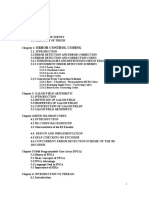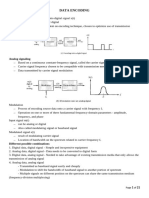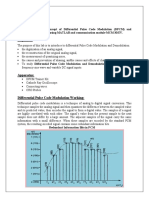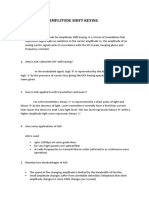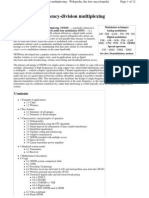Differential Coding: From Wikipedia, The Free Encyclopedia
Uploaded by
firaszekiDifferential Coding: From Wikipedia, The Free Encyclopedia
Uploaded by
firaszekiDifferential coding - Wikipedia, the free encyclopedia
Page 1 of 3
Differential coding
From Wikipedia, the free encyclopedia
In digital communications, differential coding is a technique used to provide unambiguous signal reception when using some types of modulation. It makes data to be transmitted to depend not only from the current bit (or symbol), but also from the previous one. The common types of modulation that require differential coding include phase shift keying and quadrature amplitude modulation.
Contents
1 Purposes of differential coding 2 Conventional differential coding 3 Generalized differential coding 4 Applications 5 Drawbacks 6 Other techniques to resolve a phase ambiguity 7 See also 8 External links and references
Purposes of differential coding
To demodulate BPSK one needs to make a local oscillator synchronous with the remote one. This is accomplished by a carrier recovery circuit. However, a carrier can be recovered in different ways, depending upon a valid phases count (2 for BPSK). For this coding, if a carrier is recovered incorrectly, the received data are inverted. Assuming that xi is a bit intended for transmission, and yi is a bit actually transmitted (differentially encoded), if
is transmitted, then on the decoding side
can be reconstructed, where
indicates binary or modulo-2 addition.
Now xi depends only on a difference between yi and yi 1 and not on their values. So, whether the data stream is inverted or not, the decoded data will always be correct. When data is transmitted over twisted-pair wires, it is easy to accidentally insert an extra half-twist in the cable between the transmitter and the receiver. When this happens, the received data are inverted. There are several different line codes designed to be polarity insensitive[1] -- whether the data stream is inverted or not, the decoded data will always be correct. The line codes with this property include differential Manchester encoding, bipolar encoding, NRZI, biphase mark code, coded mark inversion, and MLT-3 encoding.
http://en.wikipedia.org/wiki/Differential_coding
12/11/2009
Differential coding - Wikipedia, the free encyclopedia
Page 2 of 3
Conventional differential coding
A method illustrated above can deal with a data stream inversion (it is called 180 ambiguity). Sometimes it is enough (e.g. if BPSK is used or if other ambiguities are detected by other circuits, such as a Viterbi decoder or a frame synchronizer) and sometimes it isn't. Generally speaking, a differential coding applies to symbols (these are not necessary the same symbols as used in the modulator). To resolve 180 ambiguity only, bits are used as these symbols. When dealing with 90 ambiguity, pairs of bits are used, and triplets of bits are used to resolve 45 ambiguity (e.g. in 8PSK). A differential encoder provides the (1) operation, a differential decoder - the (2) operation. Both differential encoder and differential decoder are discrete linear time-invariant systems. The former is recursive and IIR, the latter is non-recursive and thus FIR. They can be analyzed as digital filters.
A differential decoder
A differential encoder
A differential encoder is similar to an analog integrator. It has an impulse response
and a transfer function
A differential decoder is thus similar to an analog differentiator, its impulse response being
and its transfer function
Note that in binary (modulo-2) arithmetic, addition and subtraction (and positive and negative numbers) are equivalent.
Generalized differential coding
Using the relation generally, it can be any function u is not the only way of carrying out differential encoding. More = F(y,x) provided that an equation u0 = F(y0,x) has one
http://en.wikipedia.org/wiki/Differential_coding
12/11/2009
Differential coding - Wikipedia, the free encyclopedia
Page 3 of 3
and only one solution for any y0 and u0.
Applications
Differential coding is widely used in satellite and radio relay communications together with PSK and QAM modulations.
Drawbacks
Differential coding has one significant drawback: it leads to error multiplication. That is, if one symbol such as yi was received incorrectly, two incorrect symbols xi and xi + 1 would be at the differential decoder's output, see: and . This approximately doubles the BER at signal-to-noise ratios for which errors rarely occur in consecutive symbols.
Other techniques to resolve a phase ambiguity
Differential coding is not the only way to deal with a phase ambiguity. The other popular technique is to use sync-words for this purpose. That is, if a frame synchronizer detects repeated inverted syncwords, in inverts the whole stream. This method is used in DVB-S.
See also
Phase shift keying Satellite modem
External links and references
1. ^ "Spread spectrum direct sequence" by Daniel Kraus
INTELSAT Earth Station Standard IESS-308 DVB framing structure, channel coding and modulation for 11/12 GHz satellite services (EN 300 421) Retrieved from "http://en.wikipedia.org/wiki/Differential_coding" Categories: Data transmission This page was last modified on 19 July 2009 at 22:09. Text is available under the Creative Commons Attribution-ShareAlike License; additional terms may apply. See Terms of Use for details. Wikipedia is a registered trademark of the Wikimedia Foundation, Inc., a non-profit organization.
http://en.wikipedia.org/wiki/Differential_coding
12/11/2009
You might also like
- EC8501-UNIT-5-Channel-Coding-Theorem-Linear-Block-Codes (1)No ratings yetEC8501-UNIT-5-Channel-Coding-Theorem-Linear-Block-Codes (1)19 pages
- 5CS3-01: Information Theory & Coding: Unit-3 Linear Block CodeNo ratings yet5CS3-01: Information Theory & Coding: Unit-3 Linear Block Code75 pages
- Unit Iv Linear Block Codes: Channel EncoderNo ratings yetUnit Iv Linear Block Codes: Channel Encoder26 pages
- Encoding Exercises: Analog-to-Digital Encoding: SpeechNo ratings yetEncoding Exercises: Analog-to-Digital Encoding: Speech4 pages
- Structure: Chapter 1: Error Control CodingNo ratings yetStructure: Chapter 1: Error Control Coding66 pages
- Duo Binary Modulation For Optical SystemsNo ratings yetDuo Binary Modulation For Optical Systems10 pages
- Duobinary Modulation For Optical Systems: XT DQT KT DNo ratings yetDuobinary Modulation For Optical Systems: XT DQT KT D10 pages
- Forkan EEE 520 3 Coding and Coded ModulationNo ratings yetForkan EEE 520 3 Coding and Coded Modulation28 pages
- Dilla University College of Engineering and Technology School of Electrical & Computer EngineeringNo ratings yetDilla University College of Engineering and Technology School of Electrical & Computer Engineering31 pages
- Digital Communications I: Modulation and Coding Course: Term 3 - 2008 Catharina LogothetisNo ratings yetDigital Communications I: Modulation and Coding Course: Term 3 - 2008 Catharina Logothetis43 pages
- An Application of Vector Space Theory in Data TranNo ratings yetAn Application of Vector Space Theory in Data Tran5 pages
- Data Communication & Computer Networks: Week # 05No ratings yetData Communication & Computer Networks: Week # 0541 pages
- Computer Communication and Networks-Encoding Techniques-JasminNo ratings yetComputer Communication and Networks-Encoding Techniques-Jasmin30 pages
- Differential Manchester Encoding - Wikipedia, The Free EncyclopediaNo ratings yetDifferential Manchester Encoding - Wikipedia, The Free Encyclopedia2 pages
- Computer Network (CSI-405) Lecture 01 by Pro JaveedNo ratings yetComputer Network (CSI-405) Lecture 01 by Pro Javeed13 pages
- Signal Integrity: From High-Speed to Radiofrequency ApplicationsFrom EverandSignal Integrity: From High-Speed to Radiofrequency ApplicationsNo ratings yet
- Communication Fundamentals: Frequency Modulation-FM TransmissionNo ratings yetCommunication Fundamentals: Frequency Modulation-FM Transmission27 pages
- Orthogonal Frequency-Division MultiplexingNo ratings yetOrthogonal Frequency-Division Multiplexing12 pages
- PSK31 or "Phase Shift Keying, 31 Baud" Is A Digital Radio: From Wikipedia, The Free EncyclopediaNo ratings yetPSK31 or "Phase Shift Keying, 31 Baud" Is A Digital Radio: From Wikipedia, The Free Encyclopedia3 pages
- Direct-Sequence Spread Spectrum: From Wikipedia, The Free EncyclopediaNo ratings yetDirect-Sequence Spread Spectrum: From Wikipedia, The Free Encyclopedia3 pages
- Direct-Sequence Spread Spectrum: From Wikipedia, The Free EncyclopediaNo ratings yetDirect-Sequence Spread Spectrum: From Wikipedia, The Free Encyclopedia3 pages


